La furia roja. AMD Radeon Fury X Video Card Review
Hi Geektimes! The excitement around the flagship news in the face of AMD Radeon R9 Fury X has subsided a bit, so you can carefully and accurately approach the issue of testing and evaluating the performance of a video card. In terms of the technological process, a major breakthrough did not happen - it’s the same 28 nm, but with regard to video memory ... Such changes have not happened on the market for about 7 years, perhaps since the appearance of GDDR5 - a real revolution, a breakthrough at the level of architecture of graphic cores. The HBM memory was first used by AMD in the production of video cards, and the fact that this memory is located on the same substrate as the graphics core itself deserves special attention. What does all this give? Under the cut, information about the new architecture and AMD flagship test results -R9 X Fury Radeon .
To understand the revolutionary nature of the device, several theoretical digressions must be made that will allow us to assess the scale of work of the engineers of the American company.
As I mentioned in the introduction, this is the first use of HBM type graphics memory in serial production. Crystals of the graphic core and memory chips are grown in different plants, and then they are mounted on a special substrate as a whole. The process is truly jewelry and the turnkey solution turns out to be rather fragile (much thinner than the usual graphics core), so the first insistent recommendation is not to remove the cooling system from AMD graphics cards with HBM memory on their own.


Using this kind of memory gives an advantage when rendering images in high resolutions, that is, we can safely say that the AMD Radeon R9 Fury X is designed to play in 4K resolutions. One can argue for a long time about whether “only” four gigabytes of video memory is enough for such an accelerator, but the answer to this question can be given only by the test results, and if objectively, then a larger amount cannot be established with the current generation of HBM memory.
The overall dimensions of the card are significantly reduced compared to the previous generation. So, for example, the area occupied by the graphics core and memory has decreased almost three times and, as a result, the number of elements on the board, in particular, in the power circuit, has decreased.

A key external feature was the standard water cooling system. This solution, coupled with the memory, which is integrated on the chip substrate, allowed to significantly reduce the size of the video card itself and make it almost the best choice for compact gaming systems. In addition to the top version of AMD Radeon R9 Fury X, there is the usual Radeon R9 Fury and Radeon R9 Nano. The last of this series is a “baby”, designed for mini-ITX cases.
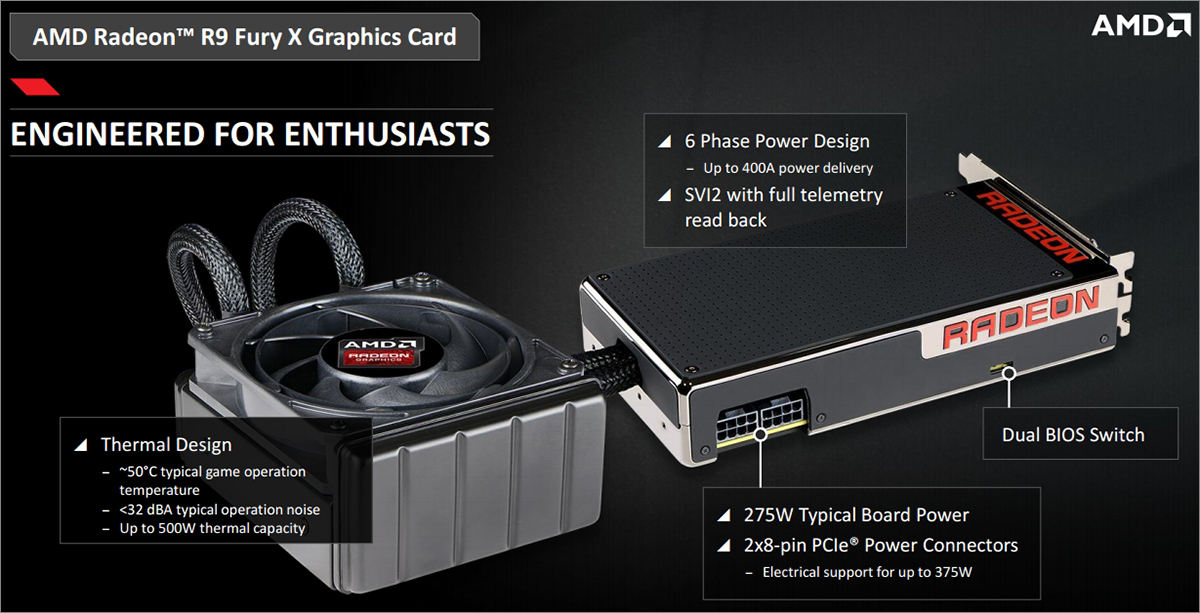
However, back to Fury X. The printed circuit board is only 190 mm in length, which is very surprising for the flagship graphics accelerator. The radiator of the liquid cooling system is designed for mounting in place of a 120 mm fan, which means there will be no problems when installing it in any modern case, even when paired with a similar radiator for the central processor.
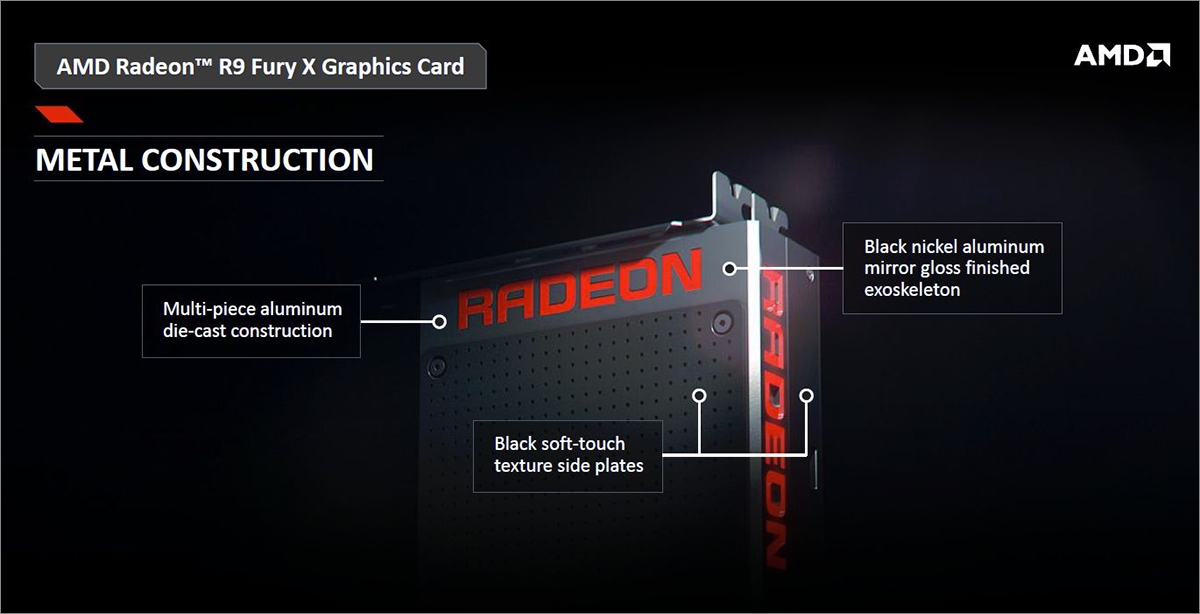

On the upper side of the video card there is a red glowing Radeon logo, which will look very good with ASUS motherboards of the ROG series (Republic Of Gamers). The plastic casing is made of plastic with a soft touch coating, which is irrelevant at first glance. Since such material collects less dust, its use, especially on video cards that will be used in powerful gaming systems with transparent cases or side windows, is one hundred percent justified.

Next to the power connectors are 8 LEDs that display the load on the graphics core. Depending on the power input, 8 or less red LEDs are lit. When entering ZeroCore Power mode, one green LED lights up.
AMD Fury X has only one competitor - the recently announced GeForce GTX 980 Ti, and competition is expected both in terms of performance and price positioning.
There are several nice features in drivers, for example, you can limit power consumption by setting the desired level of performance, fixing it, say, at 60 frames per second.
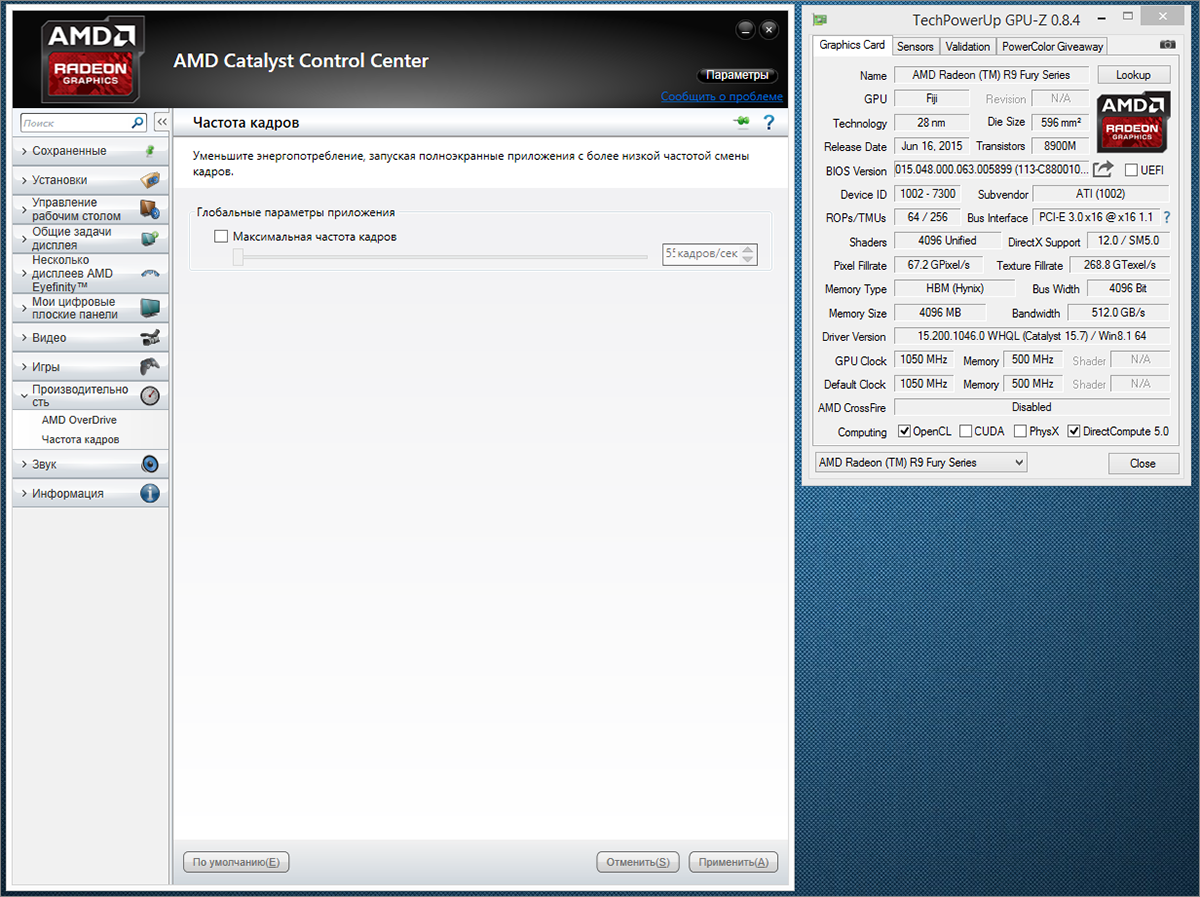
Overclocking options are still presented in the drivers in the Graphics OverDrive settings. You can choose the percentage increase in the frequency of the GPU and also increase the threshold for energy consumption. My copy of the video card was able to overclock to 1100 MHz with an increase in consumption by 15%.
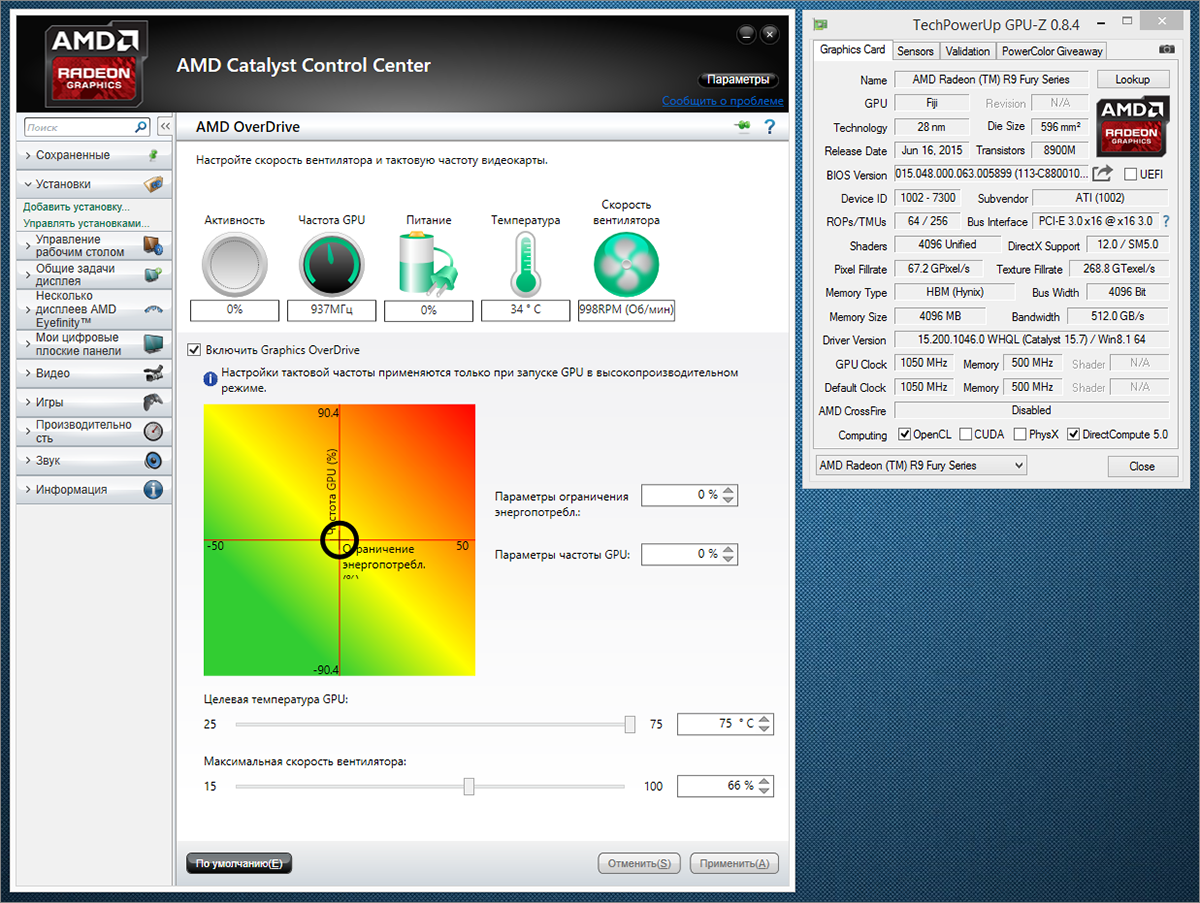
I would not want to talk about the lack of processor performance, so the following stand was assembled to test the top-end video card:
In the usual way, I will use both Futuremark synthetic tests and real games, and in particular my own benchmarks built into them.
The latest 3DMark package provides many different scenarios for various levels of performance, but for powerful game cards, only one, but three-headed, is suitable:
Fire Strike - this test has a single operation scenario, but several passing options. “Normal” - performed in 1920 * 1080 resolution (FullHD), Fire Strike Extreme - in 2560 * 1440 resolution (at the same time, a monitor with this resolution is not required for the test to work correctly, just the picture of the corresponding size is processed) and Fire Strike Ultra- where the same scenes are rendered in the resolution of 3840 * 2160 (4K).
The first game subtest uses tessellation and volumetric lighting, in the second subtest the emphasis is on integrated smoke processing on the shader conveyors of the graphics core and dynamic spot lighting. A “physical” subtest simultaneously processes the physics of a soft and elastic body on a 32-thread central processor. And the fourth subtest is combined, in it actions from the first three subtests take place simultaneously.
Game tests are represented by the following titles:
Testing will be carried out in three resolutions: 1920 * 1080 , 2560 * 1440 and 3840 * 2160 without the use of virtual super-resolution technologies. Graphics quality settings are maximum for each application. Each test was run three times to minimize probable errors.

Let's analyze the results. Synthetic tests indicate almost complete equality, both the new generation of video cards and the previous one. The difference in the results can be attributed to the measurement error, but nevertheless it is synthetics, which means the drivers can be optimized specifically for this test, so let's not rush to conclusions.
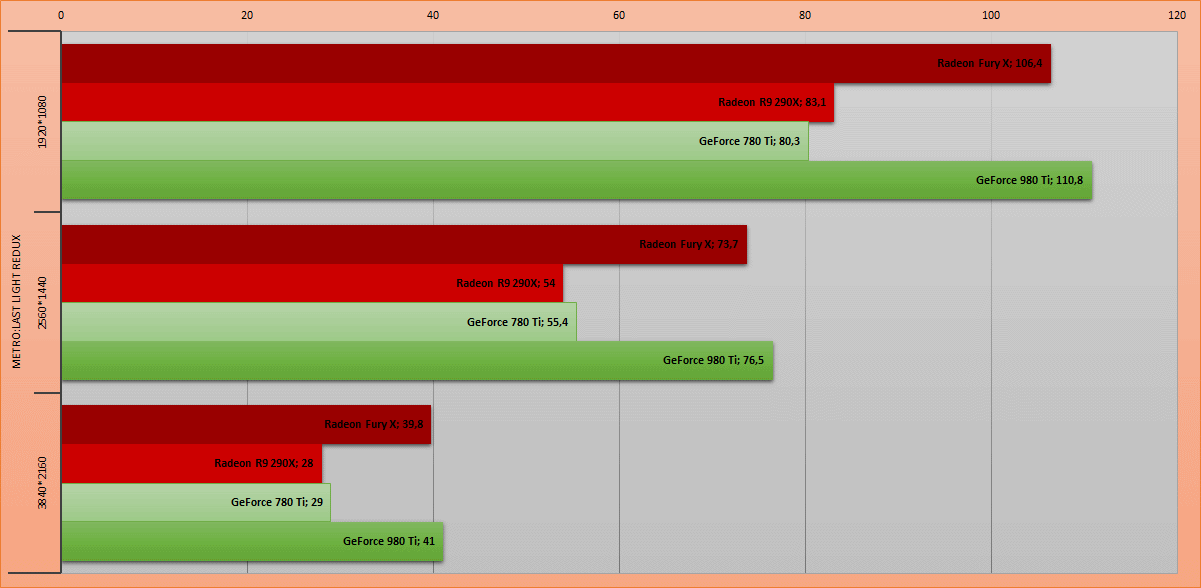
Metro: Last Light Redux game uses the A4 Engine (DirectX 11), the load on the GPU is very serious due to the use of tessellation, various lighting effects and flying particles. The alignment of forces repeats the synthetic test, almost parity between the top cards. The difference in results is 3% in maximum resolution.

The latest game from the famous Total War series. Traditionally, a large load is created both on the central (calculation of the simultaneous movement of military units) and on the graphics processor (elaboration of a large number of uniform details). In this test, in 4K resolution, the minimum (slightly less than 5%) advantage on the AMD flagship side.

The story of Talion, a ranger from Gondor, gained popularity not only because the Tolkien universe beckons young people almost stronger than all other books in the world, but also because of the highest quality graphics. The same engine as in the legendary FEAR - Lithtech, has been finalized (the latest version is called Jupiter EX ) and supports all the latest technologies: DirectX11, tessellation, spot lighting and other chips.
In this test at maximum resolution, a small victory remains with AMD Radeon R9 Fury X.

The only game on the list without a built-in benchmark. I went through the same scene several times at the beginning of the game (training Geralt in the courtyard of the castle) and recorded the result with the help of FRAPS.
We expect a tangible advantage in favor of GeForce in FullHD, in the end, the game is completely tuned for NVIDIA graphics technology. However, equality in 4K resolution may be evidence of higher performance AMD Radeon R9 Fury X precisely in high image quality.

One of the latest parts of the franchise about a pretty young lady, always looking for adventure, is made on the Crystal Engine, which made the most of DirectX11. In addition, Tomb Raider is the first game in which TressFX technology was applied (improving hair display due to parameters such as wind direction and strength, gravity, interaction with other objects and with each other).
Gentlemen prefer blondes, and Lara Croft prefers AMD - that’s how we can briefly explain the almost 10 percent advantage in favor of Radeon Fury X in 4K resolution.
The revolution has come true. HBM memory has become available to simple gamers, you no longer need to buy giant cases for a powerful gaming system, and the liquid cooling system for a video card will no longer be an exotic phenomenon. The first step towards a new level of performance has been taken; there is no doubt that the second generation of HBM memory will not take long.
The performance of the AMD Radeon R9 Fury X turned out to be very high, sufficient to calmly and unobtrusively compete with the NVIDIA GeForce GTX 980 Ti, which means that secondary factors will come to the fore when choosing: for example, the LSS in the standard delivery kit.
There are some roughnesses, such as the lack of the possibility of overclocking the memory or the potential shortage of the same memory (although this was not confirmed during the tests), but the rest of the video card can be regarded as a successful maneuver to return to the top.
The price of the AMD Fury X graphics card is 54 500 rubles, in the presence of a version from XFX and Sapphire . In addition, you can order a custom assembly of the MicroXperts computer with such a video card.
Thanks for attention!
Geek's health:
" What to do if the sound is too quiet, and how to protect your ears from too loud
" Geek's health: coffee is right
» How not to turn sour to old age
Our reviews:
"Olympus E-PL7: learn how to do state employees | Part 1
» Logitech G27: when you want to drive a sports car, Part 1 , Part 2
» Connect original gamepads to a PC
» Razer Abyssus: the most affordable Razer
» Nikon 1 S2: one-button mirrorless
» Review Lenovo Miix 3-1030
» Understanding the art chaos Wacom


Using this kind of memory gives an advantage when rendering images in high resolutions, that is, we can safely say that the AMD Radeon R9 Fury X is designed to play in 4K resolutions. One can argue for a long time about whether “only” four gigabytes of video memory is enough for such an accelerator, but the answer to this question can be given only by the test results, and if objectively, then a larger amount cannot be established with the current generation of HBM memory.
The overall dimensions of the card are significantly reduced compared to the previous generation. So, for example, the area occupied by the graphics core and memory has decreased almost three times and, as a result, the number of elements on the board, in particular, in the power circuit, has decreased.

The appearance and characteristics of the video card
A key external feature was the standard water cooling system. This solution, coupled with the memory, which is integrated on the chip substrate, allowed to significantly reduce the size of the video card itself and make it almost the best choice for compact gaming systems. In addition to the top version of AMD Radeon R9 Fury X, there is the usual Radeon R9 Fury and Radeon R9 Nano. The last of this series is a “baby”, designed for mini-ITX cases.

However, back to Fury X. The printed circuit board is only 190 mm in length, which is very surprising for the flagship graphics accelerator. The radiator of the liquid cooling system is designed for mounting in place of a 120 mm fan, which means there will be no problems when installing it in any modern case, even when paired with a similar radiator for the central processor.


On the upper side of the video card there is a red glowing Radeon logo, which will look very good with ASUS motherboards of the ROG series (Republic Of Gamers). The plastic casing is made of plastic with a soft touch coating, which is irrelevant at first glance. Since such material collects less dust, its use, especially on video cards that will be used in powerful gaming systems with transparent cases or side windows, is one hundred percent justified.

Next to the power connectors are 8 LEDs that display the load on the graphics core. Depending on the power input, 8 or less red LEDs are lit. When entering ZeroCore Power mode, one green LED lights up.
AMD Fury X has only one competitor - the recently announced GeForce GTX 980 Ti, and competition is expected both in terms of performance and price positioning.
Comparison table with test rivals:
| AMD Radeon R9 Fury X | AMD Radeon R9 290X | GeForce GTX 780 Ti | GeForce GTX 980 Ti | |
|---|---|---|---|---|
| Process technology | 28 nm | 28 nm | 28 nm | 28 nm |
| Core Size, mm 2 | 596 | 438 | 521 | 601 |
| Number of transistors | 8900 million | 6,200 million | 7,100 million | 8,000 million |
| Core frequency | 1050 MHz | 1000 MHz | 876 MHz | 1000 MHz |
| Number of Shader Processors | 4096 | 2816 | 2880 | 2816 |
| The number of texture units | 256 | 176 | 240 | 176 |
| Number of rasterization blocks | 64 | 64 | 48 | 96 |
| Maximum fill speed, Gpix / s | 67.2 | 64 | 42 | 96.2 |
| Maximum texture sampling rate, Gtex / s | 269 | 176 | 210.2 | 176 |
| Memory type | HBM | Gddr5 | Gddr5 | Gddr5 |
| Effective memory frequency | 1000 MHz | 5000 MHz | 7000 MHz | 7000 MHz |
| Memory size | 4096 Mb | 4096 Mb | 3072 Mb | 6144 Mb |
| Memory bus | 4096 bit | 512 bit | 384 bit | 384 bit |
| Memory bandwidth | 512 GB / s | 320 GB / s | 336 GB / s | 336.5 GB / s |
| Power consumption | 275 watts | 290 watts | 250 watts | 250 watts |
There are several nice features in drivers, for example, you can limit power consumption by setting the desired level of performance, fixing it, say, at 60 frames per second.

Overclocking options are still presented in the drivers in the Graphics OverDrive settings. You can choose the percentage increase in the frequency of the GPU and also increase the threshold for energy consumption. My copy of the video card was able to overclock to 1100 MHz with an increase in consumption by 15%.

Test stand
I would not want to talk about the lack of processor performance, so the following stand was assembled to test the top-end video card:
- Processor: Intel Core i7-5960X
- Motherboard: ASUS Rampage V Extreme
- RAM: HyperX Fury DDR4-2133 32 Gb (4 * 8 Gb)
- System SSD: HyperX Predator PCI-E SSD 480 Gb
- Video cards: ASUS Radeon R9 290X Matrix, AMD Radeon R9 Fury X , ASUS GeForce GTX 780Ti, ASUS GeForce GTX 980Ti
- Power Supply: Corsair AX1200i, 1200W
- Operating System: Windows 8.1 Professional (64-bit)
- Driver: AMD Catalyst 15.7 for AMD graphics cards, GeForce 353.30 for NVIDIA graphics cards
Testing methodology
In the usual way, I will use both Futuremark synthetic tests and real games, and in particular my own benchmarks built into them.
The latest 3DMark package provides many different scenarios for various levels of performance, but for powerful game cards, only one, but three-headed, is suitable:
Fire Strike - this test has a single operation scenario, but several passing options. “Normal” - performed in 1920 * 1080 resolution (FullHD), Fire Strike Extreme - in 2560 * 1440 resolution (at the same time, a monitor with this resolution is not required for the test to work correctly, just the picture of the corresponding size is processed) and Fire Strike Ultra- where the same scenes are rendered in the resolution of 3840 * 2160 (4K).
The first game subtest uses tessellation and volumetric lighting, in the second subtest the emphasis is on integrated smoke processing on the shader conveyors of the graphics core and dynamic spot lighting. A “physical” subtest simultaneously processes the physics of a soft and elastic body on a 32-thread central processor. And the fourth subtest is combined, in it actions from the first three subtests take place simultaneously.
Game tests are represented by the following titles:
- Metro: Last Light Redux
- Total War: ATTILA
- The Middle-Earth: Shadow Of Mordor
- The Witcher 3: Wild Hunt
- Tomb raider
Testing will be carried out in three resolutions: 1920 * 1080 , 2560 * 1440 and 3840 * 2160 without the use of virtual super-resolution technologies. Graphics quality settings are maximum for each application. Each test was run three times to minimize probable errors.
Test results
3DMark Fire Strike

Let's analyze the results. Synthetic tests indicate almost complete equality, both the new generation of video cards and the previous one. The difference in the results can be attributed to the measurement error, but nevertheless it is synthetics, which means the drivers can be optimized specifically for this test, so let's not rush to conclusions.
Metro: Last Light Redux

Metro: Last Light Redux game uses the A4 Engine (DirectX 11), the load on the GPU is very serious due to the use of tessellation, various lighting effects and flying particles. The alignment of forces repeats the synthetic test, almost parity between the top cards. The difference in results is 3% in maximum resolution.
Total War: ATTILA

The latest game from the famous Total War series. Traditionally, a large load is created both on the central (calculation of the simultaneous movement of military units) and on the graphics processor (elaboration of a large number of uniform details). In this test, in 4K resolution, the minimum (slightly less than 5%) advantage on the AMD flagship side.
The Middle-Earth: Shadow Of Mordor

The story of Talion, a ranger from Gondor, gained popularity not only because the Tolkien universe beckons young people almost stronger than all other books in the world, but also because of the highest quality graphics. The same engine as in the legendary FEAR - Lithtech, has been finalized (the latest version is called Jupiter EX ) and supports all the latest technologies: DirectX11, tessellation, spot lighting and other chips.
In this test at maximum resolution, a small victory remains with AMD Radeon R9 Fury X.
The Witcher 3: Wild Hunt

The only game on the list without a built-in benchmark. I went through the same scene several times at the beginning of the game (training Geralt in the courtyard of the castle) and recorded the result with the help of FRAPS.
We expect a tangible advantage in favor of GeForce in FullHD, in the end, the game is completely tuned for NVIDIA graphics technology. However, equality in 4K resolution may be evidence of higher performance AMD Radeon R9 Fury X precisely in high image quality.
Tomb raider

One of the latest parts of the franchise about a pretty young lady, always looking for adventure, is made on the Crystal Engine, which made the most of DirectX11. In addition, Tomb Raider is the first game in which TressFX technology was applied (improving hair display due to parameters such as wind direction and strength, gravity, interaction with other objects and with each other).
Gentlemen prefer blondes, and Lara Croft prefers AMD - that’s how we can briefly explain the almost 10 percent advantage in favor of Radeon Fury X in 4K resolution.
Organizational Conclusions
The revolution has come true. HBM memory has become available to simple gamers, you no longer need to buy giant cases for a powerful gaming system, and the liquid cooling system for a video card will no longer be an exotic phenomenon. The first step towards a new level of performance has been taken; there is no doubt that the second generation of HBM memory will not take long.
The performance of the AMD Radeon R9 Fury X turned out to be very high, sufficient to calmly and unobtrusively compete with the NVIDIA GeForce GTX 980 Ti, which means that secondary factors will come to the fore when choosing: for example, the LSS in the standard delivery kit.
There are some roughnesses, such as the lack of the possibility of overclocking the memory or the potential shortage of the same memory (although this was not confirmed during the tests), but the rest of the video card can be regarded as a successful maneuver to return to the top.
The price of the AMD Fury X graphics card is 54 500 rubles, in the presence of a version from XFX and Sapphire . In addition, you can order a custom assembly of the MicroXperts computer with such a video card.
Thanks for attention!
Geek's health:
" What to do if the sound is too quiet, and how to protect your ears from too loud
" Geek's health: coffee is right
» How not to turn sour to old age
Our reviews:
"Olympus E-PL7: learn how to do state employees | Part 1
» Logitech G27: when you want to drive a sports car, Part 1 , Part 2
» Connect original gamepads to a PC
» Razer Abyssus: the most affordable Razer
» Nikon 1 S2: one-button mirrorless
» Review Lenovo Miix 3-1030
» Understanding the art chaos Wacom
